Key Takeaways
- Leverage Digital Recruitment Tools – Use job portals like 9cv9 and social media to attract top talent efficiently in Iowa’s evolving job market.
- Ensure Legal Compliance – Stay updated on Iowa’s employment laws, wage regulations, and workplace policies to avoid hiring risks.
- Focus on Retention Strategies – Implement strong onboarding, career development programs, and a positive work culture to retain employees long-term.
In 2025, Iowa’s job market is evolving rapidly, presenting both opportunities and challenges for businesses looking to find and hire the right employees.
As industries such as agriculture, manufacturing, healthcare, and technology continue to expand, employers must navigate an increasingly competitive hiring landscape.
The demand for skilled professionals is rising, and companies must adopt innovative recruitment strategies to attract top talent while ensuring compliance with state labor laws and employment regulations.
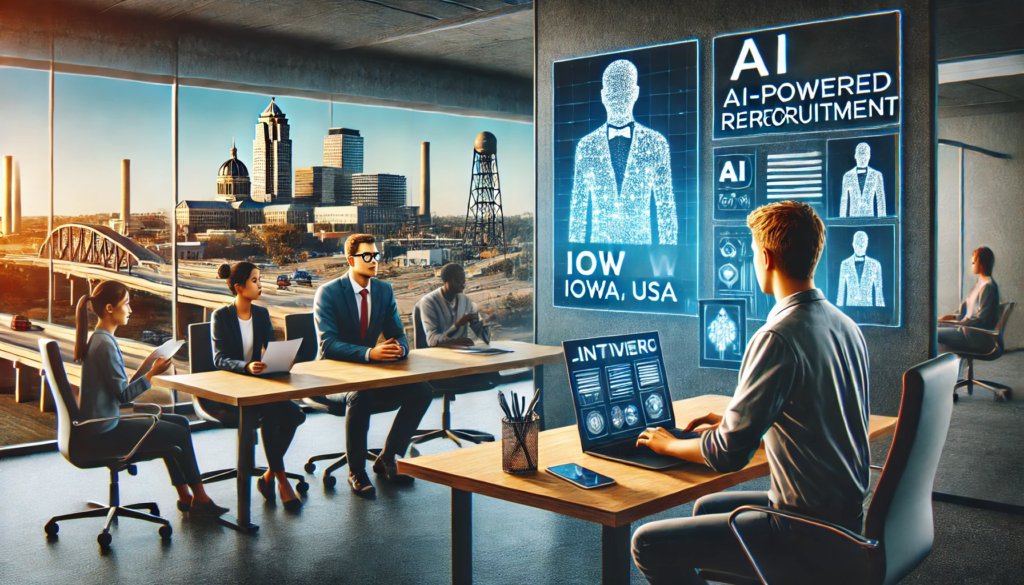
Hiring employees in Iowa requires a strategic approach that aligns with the latest workforce trends, technological advancements in recruitment, and shifting candidate expectations.
With the growing influence of artificial intelligence (AI) in recruitment, the rise of remote and hybrid work models, and the increasing importance of employer branding, businesses must adapt their hiring processes to remain competitive.
Additionally, Iowa’s workforce demographics are changing, with younger professionals entering the job market while experienced workers seek career advancement opportunities.
For businesses operating in Iowa, it is crucial to understand where and how to source the best candidates.
Leveraging job portals, collaborating with local universities and training institutions, attending job fairs, and working with recruitment agencies can all help in identifying skilled employees.
Social media and employee referrals have also become valuable tools in reaching potential hires.
Moreover, implementing structured screening, interviewing, and onboarding processes can significantly enhance the chances of hiring candidates who align with company goals and culture.
Legal and regulatory compliance is another essential aspect of the hiring process.
Iowa employers must adhere to state and federal labor laws, including minimum wage requirements, overtime regulations, equal employment opportunity (EEO) laws, and background check policies. Understanding these regulations ensures a smooth hiring process while mitigating legal risks.
Beyond recruitment, retention is a key factor in building a sustainable workforce.
Businesses must focus on providing competitive salaries, employee benefits, career development programs, and a positive work environment to reduce turnover and enhance job satisfaction.
In an era where employees seek work-life balance and job stability, fostering a strong company culture and offering growth opportunities are essential in retaining top talent.
This guide will explore the most effective strategies for finding and hiring employees in Iowa, covering the latest job market trends, sourcing techniques, hiring best practices, legal considerations, and retention strategies.
By implementing these insights, businesses can build a skilled and motivated workforce, positioning themselves for long-term success in Iowa’s dynamic job market.
Before we venture further into this article, we would like to share who we are and what we do.
About 9cv9
9cv9 is a business tech startup based in Singapore and Asia, with a strong presence all over the world.
With over nine years of startup and business experience, and being highly involved in connecting with thousands of companies and startups, the 9cv9 team has listed some important learning points in this overview of How to Find and Hire Employees in Iowa, USA in 2025.
If your company needs recruitment and headhunting services to hire top-quality employees, you can use 9cv9 headhunting and recruitment services to hire top talents and candidates. Find out more here, or send over an email to [email protected].
Or just post 1 free job posting here at 9cv9 Hiring Portal in under 10 minutes.
How to Find and Hire Employees in Iowa, USA in 2025
- Understanding the Iowa Job Market in 2025
- Defining Your Hiring Needs and Job Requirements
- Best Strategies to Find Employees in Iowa
- The Hiring Process: Steps to Ensure the Right Fit
- Navigating Employment Laws and Compliance in Iowa
- Onboarding and Retaining Employees for Long-Term Success
1. Understanding the Iowa Job Market in 2025
The Iowa job market in 2025 is shaped by several key factors, including economic growth, industry demands, workforce demographics, and evolving employment trends. As businesses look to expand, understanding these elements is crucial for hiring the right talent. Employers must stay informed about which industries are thriving, what skills are in demand, and how labor market dynamics are changing.
Key Employment Trends in Iowa for 2025
- Growth in Key Industries
- Agriculture and Agribusiness: As Iowa remains a leader in U.S. agricultural production, the demand for skilled workers in precision farming, agronomy, and supply chain logistics is increasing.
- Manufacturing and Industrial Automation: Advancements in automation and robotics are transforming the manufacturing sector, requiring workers with expertise in mechatronics, programming, and equipment maintenance.
- Healthcare and Biotechnology: An aging population is driving the need for healthcare professionals, including nurses, medical technicians, and specialized care providers. The rise of biotech firms is also fueling demand for research scientists and lab technicians.
- Technology and IT Services: The expansion of tech hubs in cities like Des Moines and Cedar Rapids has led to a surge in demand for software developers, cybersecurity experts, and data analysts.
- Renewable Energy and Sustainability: Iowa is one of the top states for wind energy production, creating job opportunities in wind turbine maintenance, energy infrastructure, and environmental engineering.
- Impact of AI and Automation on Employment
- Many traditional jobs in industries such as manufacturing, retail, and logistics are being transformed by AI-driven automation.
- Employers are prioritizing workers with technical skills to operate and manage automated systems.
- Upskilling programs and workforce development initiatives are growing to help employees transition into tech-driven roles.
- Remote and Hybrid Work Trends
- The post-pandemic era has solidified remote and hybrid work arrangements, especially in sectors like IT, finance, and digital marketing.
- Iowa-based companies are now competing with national and global employers for top remote talent.
- Businesses that offer flexible work arrangements have a competitive edge in attracting highly skilled professionals.
Labor Force and Workforce Availability
- Unemployment Rate and Workforce Participation
- Iowa has historically maintained a low unemployment rate, often below the national average.
- A strong workforce participation rate indicates a steady supply of skilled labor, but businesses may face challenges in sourcing highly specialized talent.
- Employers must implement targeted recruitment strategies to attract workers from underutilized labor pools, such as recent graduates and career changers.
- Demographic Shifts in the Workforce
- Aging Workforce: A significant portion of Iowa’s workforce is approaching retirement age, increasing demand for succession planning and knowledge transfer programs.
- Rising Millennial and Gen Z Workforce: Younger professionals prioritize workplace flexibility, career growth, and company culture, influencing hiring strategies.
- Increasing Diversity and Inclusion: Companies that embrace diversity hiring practices benefit from a broader talent pool and improved employee retention.
Skills and Qualifications in High Demand
- Technical and Digital Skills
- Employers seek candidates with expertise in data analytics, cybersecurity, AI development, and cloud computing.
- The rise of Industry 4.0 has made skills in automation programming and smart manufacturing essential.
- Healthcare and Life Sciences Skills
- Demand is growing for registered nurses, medical assistants, and healthcare administrators.
- Biotechnology firms need specialized researchers with expertise in genetics, microbiology, and pharmaceuticals.
- Soft Skills and Leadership Abilities
- Critical thinking, adaptability, and emotional intelligence are becoming equally as important as technical skills.
- Companies are prioritizing employees with strong communication, problem-solving, and team collaboration skills.
Examples of Job Market Changes in Iowa
- Example 1: Manufacturing Sector Evolution
- Traditional factory jobs in Iowa’s major industrial hubs, such as Cedar Rapids and Davenport, are being replaced by roles requiring automation and robotics expertise.
- Companies like John Deere are investing in advanced manufacturing techniques, creating demand for engineers and tech-driven production workers.
- Example 2: Healthcare Industry Growth
- The University of Iowa Hospitals and Clinics is expanding its workforce due to an increasing patient population, requiring more medical professionals and administrative staff.
- Telehealth services are growing, leading to new job opportunities in virtual healthcare support and digital health management.
- Example 3: IT and Tech Boom in Des Moines
- Startups and tech firms in Des Moines are hiring more software engineers and data scientists as the city becomes a growing tech hub.
- Companies like Workiva are attracting skilled professionals from both within Iowa and other states, intensifying competition for top tech talent.
Conclusion
Understanding Iowa’s job market in 2025 is essential for employers looking to attract and retain top talent. With significant growth in industries such as manufacturing, healthcare, technology, and renewable energy, businesses must adapt their hiring strategies to align with emerging trends. Demographic shifts, remote work preferences, and evolving skill demands are reshaping workforce expectations, making it crucial for employers to stay ahead by leveraging data-driven recruitment strategies, upskilling initiatives, and competitive employee benefits.
2. Defining Your Hiring Needs and Job Requirements
A well-defined hiring strategy is essential for attracting the right talent in Iowa’s evolving job market. As industries adapt to technological advancements and workforce expectations shift, businesses must clearly outline their hiring needs and job requirements. This ensures that recruitment efforts align with company goals while effectively addressing skill shortages, workforce availability, and industry demands.
Assessing Business Growth and Workforce Needs
Before initiating the hiring process, businesses must evaluate their long-term workforce requirements based on industry trends, business expansion plans, and operational needs.
- Evaluating Current Workforce and Skill Gaps
- Conduct a workforce audit to identify areas where talent shortages exist.
- Analyze employee performance and productivity metrics to determine if additional hiring is necessary.
- Consider upskilling or reskilling existing employees to bridge skill gaps instead of hiring new talent.
- Identifying Future Workforce Demands
- Assess industry growth trends in Iowa to anticipate future job roles and skills in demand.
- Plan for leadership succession to replace retiring employees, particularly in industries with an aging workforce.
- Develop talent acquisition strategies aligned with business growth objectives, whether for short-term projects or long-term staffing.
- Determining Hiring Priorities
- Establish whether new hires are needed for full-time, part-time, contract, or freelance positions.
- Consider the benefits of remote, hybrid, or in-office roles based on job function and company policies.
- Set hiring budgets, including salary ranges, benefits, and recruitment costs.
Defining Job Roles and Responsibilities
Clearly defining job roles ensures that job descriptions attract the right candidates while preventing hiring mismatches.
- Creating Clear and Concise Job Titles
- Use industry-standard job titles to avoid confusion and increase job post visibility.
- Avoid overly creative titles that may not align with job seekers’ search terms.
- Example: Instead of “Marketing Ninja,” use “Digital Marketing Specialist.”
- Outlining Key Responsibilities
- Define daily tasks, responsibilities, and expectations for each role.
- Differentiate between essential job functions and secondary responsibilities.
- Example: A Software Developer at a Des Moines-based tech company may need to:
- Develop and test software applications.
- Collaborate with cross-functional teams.
- Ensure compliance with data security regulations.
- Setting Performance Expectations
- Define productivity metrics and key performance indicators (KPIs) for each role.
- Establish probationary periods and evaluation criteria for new hires.
Determining Essential Skills and Qualifications
Hiring the right talent requires a clear understanding of the skills and qualifications necessary for each role.
- Technical and Industry-Specific Skills
- Outline technical expertise required for job success.
- Consider certifications, software proficiency, and hands-on experience.
- Example: A Wind Turbine Technician in Iowa may require:
- Expertise in mechanical and electrical troubleshooting.
- Certification from the North American Board of Certified Energy Practitioners (NABCEP).
- Soft Skills and Workplace Abilities
- Employers are increasingly prioritizing adaptability, problem-solving, and teamwork.
- Example: A Customer Service Representative in Iowa’s growing financial sector should demonstrate:
- Strong communication and interpersonal skills.
- The ability to handle conflict resolution effectively.
- Education and Experience Requirements
- Specify minimum education levels, degrees, or certifications required.
- Consider experience levels, but avoid excessive requirements that may limit qualified candidates.
- Example: An Entry-Level IT Support Specialist may require:
- A degree in Information Technology or a related field.
- One year of relevant experience or an equivalent certification (e.g., CompTIA A+).
Aligning Job Requirements with Iowa’s Workforce Trends
To attract top talent, job requirements should align with current workforce expectations and labor market trends in Iowa.
- Adapting to Remote and Hybrid Work Preferences
- Determine whether positions can be remote, hybrid, or fully on-site.
- Example: A Digital Marketing Manager role may be offered as remote to attract nationwide talent.
- Incorporating Diversity, Equity, and Inclusion (DEI) Practices
- Iowa businesses are prioritizing inclusive hiring to build diverse teams.
- Example: Employers in healthcare and education are emphasizing bilingual skills to serve diverse populations.
- Considering Generational Workforce Preferences
- Millennials and Gen Z professionals prioritize career growth and work-life balance.
- Offering mentorship programs and professional development can enhance job attractiveness.
Writing a Compelling Job Description
A well-structured job description enhances candidate engagement and improves hiring success.
- Optimizing Job Descriptions for SEO
- Use keywords that job seekers frequently search for.
- Example: Instead of “Tech Specialist,” use “IT Support Specialist in Des Moines, Iowa.”
- Highlighting Company Culture and Benefits
- Include details about workplace environment, company values, and career growth opportunities.
- Example: A Cedar Rapids manufacturing firm may emphasize:
- Career advancement opportunities.
- Tuition reimbursement for technical certifications.
- Providing Clear Application Instructions
- Specify how candidates should apply (e.g., online application, email submission).
- Include necessary documents such as resumes, cover letters, or portfolios.
Conclusion
Defining hiring needs and job requirements is a critical step in Iowa’s competitive job market. Employers must assess workforce demands, outline job responsibilities, and set clear skill expectations to attract the right candidates. By aligning job descriptions with workforce trends, leveraging SEO-friendly job postings, and prioritizing inclusive hiring practices, businesses can enhance their recruitment strategies and secure top talent in 2025.
3. Best Strategies to Find Employees in Iowa
Finding skilled employees in Iowa requires a multi-faceted recruitment strategy that leverages digital platforms, local networks, and modern hiring trends. As businesses compete for top talent in industries such as manufacturing, healthcare, technology, and agriculture, implementing the right hiring methods is essential. In 2025, Iowa employers must adopt data-driven and technology-enabled recruitment strategies to attract, engage, and retain employees effectively.
Leveraging Online Job Portals and Recruitment Agencies
Online job platforms and recruitment agencies play a vital role in streamlining the hiring process by connecting employers with qualified candidates.
- 9cv9 Job Portal
- A leading job portal that helps businesses in Iowa find skilled professionals across various industries.
- Offers advanced filtering options to refine candidate searches based on experience, skills, and job preferences.
- Example: A software development company in Des Moines can use 9cv9 to post IT job openings and attract skilled developers looking for opportunities in Iowa.
- 9cv9 Recruitment Agency
- Specializes in end-to-end recruitment solutions, including talent sourcing, screening, and placement.
- Ideal for companies seeking assistance in hiring highly specialized or hard-to-fill positions.
- Example: A manufacturing firm in Cedar Rapids struggling to find experienced CNC machinists can partner with 9cv9 to identify top candidates.
- Other Online Job Boards
- Indeed, LinkedIn, and Glassdoor: Widely used job platforms where employers can post job openings and actively engage with potential hires.
- ZipRecruiter and CareerBuilder: AI-driven job platforms that match candidates with job postings based on skills and location.
Utilizing Local and Niche Job Boards
For businesses hiring in Iowa, leveraging region-specific and industry-focused job boards can enhance candidate outreach.
- IowaWORKS (State of Iowa’s Job Portal)
- Provides a database of job seekers across multiple industries, including government and education.
- Example: A public sector employer in Iowa City can use IowaWORKS to find qualified administrative professionals.
- HigherEdJobs and Educate Iowa
- Ideal for hiring faculty, researchers, and academic professionals in Iowa’s universities and colleges.
- AgCareers
- A niche job board dedicated to agricultural and agribusiness positions, relevant to Iowa’s farming industry.
- Example: A grain production company in Ames can find agricultural engineers and farm managers.
Building a Strong Employer Brand
A compelling employer brand attracts top talent by showcasing a company’s culture, values, and benefits.
- Developing an Attractive Company Profile
- Maintain an updated company page on LinkedIn, Glassdoor, and 9cv9 to highlight work culture and employee success stories.
- Example: A financial services firm in West Des Moines can share employee testimonials to enhance employer credibility.
- Offering Competitive Compensation and Benefits
- Ensure salary packages align with Iowa’s labor market standards.
- Provide benefits such as flexible work arrangements, tuition reimbursement, and career development opportunities.
- Example: A healthcare facility in Cedar Rapids can offer sign-on bonuses for registered nurses to attract top talent.
- Enhancing Workplace Diversity and Inclusion
- Promote inclusive hiring practices to attract a diverse workforce.
- Develop DEI programs and showcase them in job postings and recruitment marketing.
Tapping into Social Media Recruitment
Social media platforms are powerful tools for connecting with job seekers and promoting job openings.
- Using LinkedIn for Professional Networking
- Post job openings and engage with industry professionals through LinkedIn groups.
- Utilize LinkedIn Recruiter to proactively search for candidates.
- Example: A tech startup in Iowa can join software development groups to attract programmers.
- Recruiting on Facebook and Twitter (X)
- Leverage Facebook Jobs and community groups to reach local job seekers.
- Use Twitter hashtags like #IowaJobs or #NowHiring to attract applicants.
- Engaging Candidates Through Instagram and TikTok
- Showcase workplace culture through employee stories, behind-the-scenes content, and recruitment videos.
- Example: A restaurant chain in Iowa can use TikTok to highlight career growth opportunities in hospitality.
Partnering with Universities and Technical Colleges
Iowa is home to several universities and technical institutions that provide access to fresh talent.
- Collaborating with Career Services Departments
- Partner with universities such as the University of Iowa and Iowa State University to recruit graduates.
- Participate in on-campus career fairs to connect with students and recent graduates.
- Offering Internships and Apprenticeships
- Develop internship programs to build a pipeline of future employees.
- Example: A biotechnology firm in Ames can offer research internships to biology students.
- Engaging with Trade Schools and Vocational Programs
- Connect with institutions like Des Moines Area Community College to hire skilled trade workers.
- Example: A construction company can recruit HVAC technicians from trade schools.
Utilizing Employee Referrals and Networking
Employee referrals are one of the most effective ways to find high-quality candidates.
- Implementing an Employee Referral Program
- Offer incentives such as bonuses or gift cards for successful referrals.
- Encourage employees to share job openings within their networks.
- Attending Industry Conferences and Networking Events
- Join Iowa Business Council (IBC) events to connect with professionals in various industries.
- Example: A logistics company can network with supply chain experts at transportation conferences.
- Engaging with Local Business Associations
- Partner with the Greater Des Moines Partnership and local chambers of commerce to find talent.
Working with Staffing Agencies and Headhunters
Recruitment firms can help businesses fill roles quickly and efficiently.
- 9cv9 Recruitment Agency
- Specializes in matching employers with high-quality candidates.
- Provides customized recruitment solutions for various industries in Iowa.
- Specialized Staffing Agencies in Iowa
- Aerotek (Manufacturing and engineering roles).
- Robert Half (Finance and administrative professionals).
- TEKsystems (IT and tech recruitment).
Using AI and Data-Driven Hiring Technologies
AI-driven hiring tools improve recruitment efficiency and candidate matching.
- Utilizing AI Resume Screening Software
- Platforms like 9cv9 and ZipRecruiter use AI to filter applications based on job criteria.
- Conducting Virtual Interviews and Skill Assessments
- Tools like HireVue and Spark Hire streamline remote hiring.
- Example: A customer support center in Iowa can use AI chatbots for initial candidate screening.
Conclusion
Finding top talent in Iowa in 2025 requires a combination of digital recruitment, social media outreach, networking, and strategic partnerships. Employers should leverage job portals like 9cv9, partner with universities, optimize their employer brand, and integrate AI-driven hiring technologies. By adopting a multi-channel recruitment approach, businesses can attract the best employees and gain a competitive edge in Iowa’s evolving job market.
4. The Hiring Process: Steps to Ensure the Right Fit
Hiring the right employees in Iowa requires a structured and strategic approach to ensure candidates not only meet job requirements but also align with company culture and long-term business goals. In 2025, with advancements in AI-driven recruitment, evolving labor laws, and shifting workforce expectations, employers must follow a comprehensive hiring process to attract, evaluate, and onboard top talent effectively.
1. Crafting a Well-Defined Job Description
A clear and compelling job description is the foundation of an effective hiring process. It helps attract the right candidates and sets expectations for the role.
- Include Key Job Responsibilities
- Clearly define daily tasks and long-term responsibilities.
- Example: A manufacturing company in Cedar Rapids hiring a production supervisor should outline quality control, team management, and workflow coordination duties.
- Specify Required Skills and Qualifications
- Highlight essential skills, education, and certifications.
- Example: A healthcare facility in Des Moines hiring a registered nurse should include state licensing requirements.
- Mention Salary, Benefits, and Work Conditions
- Provide transparency regarding compensation and perks to attract competitive candidates.
- Example: A tech startup in Iowa City can highlight remote work options and professional development opportunities.
2. Choosing the Right Recruitment Channels
Selecting the most effective recruitment channels ensures a wider reach and access to high-quality candidates.
- Online Job Portals
- Post openings on platforms such as 9cv9, Indeed, LinkedIn, and IowaWORKS.
- Example: A software firm in Ames can use 9cv9 to find skilled developers.
- Recruitment Agencies and Headhunters
- Engage services like 9cv9 Recruitment Agency for specialized hiring needs.
- Example: A logistics company in Sioux City can use headhunters to find experienced supply chain managers.
- Social Media Recruiting
- Promote job openings on LinkedIn, Facebook, and industry-specific groups.
- Example: A restaurant chain in Iowa can attract hospitality staff through Instagram job ads.
3. Screening and Shortlisting Candidates
Efficient screening methods help identify the most suitable applicants quickly.
- AI Resume Screening Tools
- Utilize AI-driven platforms like 9cv9 and ZipRecruiter to filter applications based on job criteria.
- Example: A finance firm in West Des Moines can use AI to shortlist accountants with CPA certification.
- Phone or Video Pre-Screening
- Conduct initial assessments to verify basic qualifications and salary expectations.
- Example: A retail company in Davenport can screen customer service candidates via short video calls.
- Skills and Experience Evaluation
- Compare candidates’ experience with job requirements.
- Check for red flags such as frequent job-hopping or employment gaps.
4. Conducting Structured Interviews
Well-planned interviews help assess candidates’ competencies, problem-solving skills, and cultural fit.
- Behavioral and Situational Interviews
- Ask candidates to describe past experiences to gauge how they handle challenges.
- Example: A construction company in Cedar Rapids can ask project managers how they handled past budget overruns.
- Technical Assessments and Work Samples
- Evaluate job-specific skills through assessments.
- Example: A cybersecurity firm in Iowa can test ethical hackers on vulnerability detection.
- Panel Interviews
- Involve multiple stakeholders to ensure an unbiased evaluation.
- Example: A university in Iowa City can conduct faculty hiring interviews with department heads and senior professors.
5. Conducting Background Checks and Reference Verification
Ensuring the credibility and reliability of candidates minimizes hiring risks.
- Employment and Education Verification
- Confirm past job roles and academic credentials.
- Example: A biotech firm in Ames verifying a researcher’s PhD credentials.
- Criminal Background and Drug Screening
- Check compliance with Iowa’s legal requirements for certain roles.
- Example: A healthcare provider ensuring nurses meet patient safety regulations.
- Reference Checks with Previous Employers
- Contact former managers to validate work ethic and performance.
- Example: A marketing agency in Des Moines checking if a candidate successfully managed past advertising campaigns.
6. Making the Job Offer and Negotiating Terms
An attractive and well-structured job offer improves acceptance rates.
- Drafting a Clear Job Offer Letter
- Include salary, benefits, work schedule, and job responsibilities.
- Example: A law firm in Iowa City providing an offer letter with partnership growth opportunities.
- Handling Salary Negotiations
- Be flexible while ensuring internal pay equity.
- Example: A tech startup in Cedar Rapids negotiating stock options with senior developers.
- Setting a Response Deadline
- Give candidates a reasonable timeframe to accept the offer.
7. Onboarding and Training for New Employees
A well-structured onboarding process ensures new hires integrate smoothly into the organization.
- Pre-Employment Paperwork and Orientation
- Handle tax forms, contracts, and benefits enrollment before the start date.
- Example: A manufacturing plant in Iowa organizing safety training for factory workers.
- Mentorship and Training Programs
- Assign mentors to help new hires navigate their roles.
- Example: A banking firm in Des Moines pairing new analysts with experienced financial advisors.
- Performance Expectations and Goal Setting
- Define key performance indicators (KPIs) for the first 90 days.
- Example: A sales company in Sioux Falls setting targets for new sales representatives.
Conclusion
An effective hiring process in Iowa in 2025 requires a structured approach, leveraging advanced recruitment tools, thorough screening, and strategic onboarding. Employers should utilize job portals like 9cv9, conduct structured interviews, perform detailed background checks, and implement strong onboarding programs. By following these steps, businesses can secure top talent that aligns with their organizational goals and contributes to long-term success.
5. Navigating Employment Laws and Compliance in Iowa
Ensuring compliance with employment laws is crucial for businesses operating in Iowa. In 2025, evolving federal and state labor regulations impact hiring practices, employee rights, workplace safety, wages, and benefits. Employers must stay updated on legal requirements to avoid penalties, lawsuits, or reputational damage. This section provides a comprehensive guide to understanding and navigating Iowa’s employment laws and compliance standards in 2025.
1. Understanding Federal and Iowa State Labor Laws
Businesses in Iowa must adhere to both federal labor regulations and state-specific employment laws.
- Federal Employment Laws (Applicable to all U.S. states)
- Fair Labor Standards Act (FLSA): Establishes minimum wage, overtime pay, and child labor rules.
- Americans with Disabilities Act (ADA): Prohibits workplace discrimination against individuals with disabilities.
- Family and Medical Leave Act (FMLA): Provides eligible employees with unpaid, job-protected leave for family or medical reasons.
- Occupational Safety and Health Act (OSHA): Sets workplace safety and health standards.
- Iowa-Specific Employment Laws (Additional requirements for employers in the state)
- Iowa Wage Payment Collection Act: Regulates wage payment frequency and protects employees from wrongful wage deductions.
- Iowa Civil Rights Act: Expands protections against discrimination in hiring, promotions, and workplace practices.
- Iowa Drug Testing Laws: Governs pre-employment and random drug testing for specific industries.
- Right-to-Work Law: Ensures employees cannot be compelled to join a union as a condition of employment.
Example:
A manufacturing company in Des Moines must comply with both FLSA for minimum wage and overtime pay, and Iowa’s Drug Testing Laws if conducting pre-employment screenings for factory workers.
2. Wage and Hour Compliance in Iowa
Employers must ensure they meet wage requirements, overtime rules, and proper employee classification.
- Minimum Wage Laws
- Iowa’s minimum wage remains at $7.25 per hour in 2025 unless updated by new legislation.
- Some cities or counties may set higher minimum wages.
- Overtime Regulations
- Employees covered by FLSA must receive overtime pay (1.5 times the regular rate) for hours worked beyond 40 per week.
- Exempt employees (e.g., salaried professionals, executives) must meet specific salary and job duty criteria.
- Employee Classification (W-2 vs. 1099 Workers)
- W-2 Employees: Subject to minimum wage, overtime, and benefits laws.
- 1099 Independent Contractors: Not covered under wage and overtime laws but must meet the IRS criteria to avoid misclassification penalties.
Example:
A tech startup in Iowa City hiring software engineers must correctly classify remote workers as either employees or independent contractors to avoid legal repercussions.
3. Hiring and Anti-Discrimination Laws
Employers must ensure a fair hiring process that complies with federal and state anti-discrimination laws.
- Protected Categories Under Iowa Law
- Race, color, religion, sex, sexual orientation, gender identity, national origin, disability, and age (40+).
- Compliance with the Equal Employment Opportunity (EEO) Act
- All job advertisements, interview questions, and hiring decisions must be free from bias.
- Employers should document hiring decisions to defend against discrimination claims.
- Ban-the-Box Legislation
- Employers cannot inquire about an applicant’s criminal history on job applications unless required by law.
- Background checks should only be conducted after a conditional job offer.
Example:
A healthcare facility in Cedar Rapids hiring nurses cannot reject a qualified candidate solely based on past criminal history unless directly relevant to patient safety.
4. Workplace Safety and OSHA Compliance
Ensuring a safe work environment is a legal requirement under Iowa OSHA (I-OSHA) regulations.
- Key Safety Requirements
- Employers must provide a hazard-free workplace, conduct regular safety training, and maintain proper recordkeeping.
- High-risk industries such as construction, agriculture, and manufacturing must comply with additional OSHA standards.
- Mandatory Safety Training
- Employees must receive training on handling hazardous materials, emergency procedures, and personal protective equipment (PPE).
- Workers’ Compensation Insurance
- Iowa law requires most employers to carry workers’ compensation insurance to cover medical expenses and lost wages for work-related injuries.
Example:
A construction company in Sioux City must ensure all workers wear PPE, attend regular safety drills, and comply with I-OSHA’s fall protection standards.
5. Employee Benefits and Leave Laws
Employers must provide legally mandated benefits while ensuring compliance with Iowa’s leave policies.
- Mandatory Employee Benefits
- Unemployment Insurance: Required for businesses with employees in Iowa.
- Workers’ Compensation: Covers employees injured on the job.
- Social Security and Medicare Contributions: Payroll tax deductions apply.
- Paid and Unpaid Leave Policies
- Family and Medical Leave (FMLA): Covers up to 12 weeks of unpaid leave for eligible employees.
- Sick Leave: Not mandatory in Iowa but encouraged for employee well-being.
- Parental Leave: Some employers offer paid parental leave beyond federal requirements.
Example:
A corporate firm in West Des Moines offering paid maternity leave gains a competitive advantage in attracting skilled professionals.
6. Employee Termination and Layoff Laws
Proper termination practices prevent legal disputes and wrongful termination claims.
- At-Will Employment Doctrine
- Employers can terminate employees without cause, provided there is no discrimination or contractual violation.
- Exceptions: Termination cannot violate anti-discrimination laws or public policy.
- Advance Notice for Layoffs
- The Worker Adjustment and Retraining Notification (WARN) Act requires businesses with 100+ employees to provide a 60-day notice for mass layoffs.
- Severance Pay and Final Paycheck Requirements
- Iowa does not require severance pay but encourages fair compensation practices.
- Final wages must be paid by the next scheduled payday following termination.
Example:
A retail chain in Davenport closing multiple stores must provide WARN Act notices to affected employees at least 60 days in advance.
7. Compliance Audits and Legal Best Practices
Conducting regular compliance audits helps employers stay updated with employment laws and avoid penalties.
- Internal HR Audits
- Review wage structures, hiring practices, and termination policies annually.
- Maintain proper documentation for all employment decisions.
- Legal Counsel and HR Consulting
- Partnering with 9cv9 Recruitment Agency or labor law attorneys can help businesses navigate complex employment regulations.
- Use of HR Technology and Compliance Tools
- Implement payroll software, background check tools, and EEO tracking systems to streamline compliance.
Example:
A growing AI startup in Des Moines using HR software for legal compliance reduces the risk of payroll errors and tax penalties.
Conclusion
Navigating employment laws and compliance in Iowa in 2025 requires businesses to stay informed about wage laws, anti-discrimination policies, workplace safety, benefits, and termination regulations. By leveraging HR audits, legal counsel, and compliance software, employers can ensure legal adherence while fostering a fair and productive workplace. Partnering with recruitment services like 9cv9 Job Portal and 9cv9 Recruitment Agency can also help companies streamline hiring while maintaining compliance with Iowa labor laws.
6. Onboarding and Retaining Employees for Long-Term Success
Employee onboarding and retention are critical factors in building a productive, engaged, and loyal workforce. In Iowa, where industries such as technology, healthcare, manufacturing, and agriculture continue to evolve, businesses must implement structured onboarding programs and long-term retention strategies to remain competitive. A well-executed onboarding process sets employees up for success, while effective retention strategies reduce turnover and enhance workplace satisfaction.
This section explores the best practices for onboarding and retaining employees in Iowa in 2025, ensuring long-term success for businesses and their workforce.
1. Designing an Effective Employee Onboarding Program
A structured onboarding process improves employee productivity, engagement, and retention by helping new hires integrate into the company culture and understand their roles effectively.
Key Elements of a Successful Onboarding Process
- Pre-boarding Activities (Before Day One)
- Send a welcome email with company resources, expectations, and an introduction to the team.
- Provide digital access to employee handbooks, benefits packages, and workplace policies.
- Assign a mentor or buddy to assist with the transition.
- First-Day Orientation
- Conduct a company tour (physical or virtual) to introduce key departments and leadership.
- Explain workplace policies, compliance regulations, and job responsibilities in detail.
- Provide login credentials for necessary tools, software, and internal communication platforms.
- First-Week Training and Integration
- Conduct role-specific training sessions to ensure employees understand expectations.
- Encourage team collaboration through ice-breakers, informal meetings, or group projects.
- Set up regular check-ins with HR and direct supervisors for feedback.
- First 90 Days Performance Milestones
- Establish key performance indicators (KPIs) to measure employee progress.
- Offer feedback sessions to address challenges and provide additional training if necessary.
- Recognize achievements through small incentives, bonuses, or acknowledgment in team meetings.
Example:
A marketing agency in Des Moines implements a digital onboarding process using an HR management system that automates training, document submissions, and goal-setting, reducing onboarding time from two weeks to five days.
2. Creating a Positive Workplace Culture for Employee Retention
A strong workplace culture enhances employee satisfaction and reduces turnover rates. Employees who feel valued, respected, and connected to their organization are more likely to stay long-term.
Building a Supportive Company Culture
- Encourage Open Communication
- Implement regular town hall meetings, surveys, and anonymous feedback channels.
- Promote an open-door policy where employees feel comfortable voicing concerns.
- Diversity, Equity, and Inclusion (DEI) Initiatives
- Offer diversity training programs to ensure a fair and inclusive work environment.
- Develop mentorship programs to support underrepresented groups in career growth.
- Recognition and Rewards Programs
- Establish monthly or quarterly employee appreciation awards.
- Offer monetary bonuses, paid time off, or professional development incentives.
Example:
A logistics company in Cedar Rapids introduces an “Employee of the Month” program with perks such as priority parking spots, gift cards, or additional vacation days, leading to increased employee morale.
3. Offering Competitive Compensation and Benefits Packages
A strong compensation strategy is essential to attracting and retaining top talent in Iowa’s competitive job market.
Key Compensation Strategies
- Market-Competitive Salaries
- Conduct annual salary benchmarking to stay competitive within the industry.
- Offer performance-based salary increases and bonuses.
- Comprehensive Benefits Packages
- Provide health insurance, dental and vision coverage, and retirement plans.
- Offer flexible spending accounts (FSAs) and health savings accounts (HSAs) for medical expenses.
- Additional Perks and Incentives
- Provide tuition reimbursement for continuing education.
- Offer remote or hybrid work options where applicable.
Example:
A tech startup in Iowa City introduces a student loan repayment assistance program, attracting young professionals and reducing early career turnover.
4. Employee Engagement and Career Development Opportunities
Career development is a significant factor in employee retention. Employees who see a clear growth path within a company are more likely to stay long-term.
Strategies for Professional Growth and Engagement
- Ongoing Training and Upskilling Programs
- Provide access to online courses, workshops, and industry certifications.
- Implement cross-training programs to help employees develop new skills.
- Clear Career Progression Paths
- Establish internal promotion policies and career advancement roadmaps.
- Offer leadership development programs for high-potential employees.
- Mentorship and Coaching Programs
- Pair junior employees with experienced mentors to guide their professional growth.
- Organize peer-to-peer learning sessions to foster a collaborative work environment.
Example:
A financial services firm in West Des Moines introduces an internal career development program where employees can apply for leadership roles after completing a 12-month training course, reducing turnover by 20 percent.
5. Enhancing Work-Life Balance and Employee Well-Being
Employees are more likely to stay with companies that prioritize their well-being and offer a healthy work-life balance.
Flexible Work Arrangements
- Hybrid and Remote Work Policies
- Allow employees to work remotely a few days a week where feasible.
- Provide the necessary technology and tools for seamless virtual collaboration.
- Paid Time Off (PTO) Policies
- Offer flexible PTO policies, including mental health days and sabbaticals.
- Encourage employees to take breaks to prevent burnout.
- Wellness Programs
- Introduce mental health resources, such as counseling and stress management workshops.
- Offer on-site gym memberships or stipends for wellness activities.
Example:
A manufacturing company in Davenport implements a four-day workweek experiment for non-production staff, leading to increased productivity and employee satisfaction.
6. Building Strong Employee Relationships and Team Collaboration
Fostering positive relationships within the workplace leads to higher engagement and job satisfaction.
Employee Bonding Activities
- Team-Building Events
- Organize quarterly team retreats, volunteer days, or sports activities.
- Encourage team lunches or informal gatherings to strengthen relationships.
- Internal Networking Opportunities
- Create company-wide Slack or Microsoft Teams channels for cross-departmental collaboration.
- Host “Lunch & Learn” sessions where employees share expertise on various topics.
Example:
A healthcare facility in Sioux City hosts monthly cross-department networking events, improving employee engagement and inter-team communication.
7. Leveraging HR Technology for Retention Success
HR technology can streamline onboarding, engagement, and retention processes.
Implementing AI-Powered HR Tools
- HR Analytics for Retention Predictions
- Use AI to identify turnover risks and implement proactive retention strategies.
- Automated Employee Feedback Systems
- Deploy pulse surveys and AI-driven sentiment analysis to assess employee satisfaction.
Example:
A retail chain in Iowa partners with 9cv9 Recruitment Agency to implement an AI-based HR analytics tool that predicts employee turnover and suggests intervention strategies.
Conclusion
Onboarding and retaining employees for long-term success in Iowa in 2025 requires a strategic approach that includes structured onboarding, a positive workplace culture, competitive compensation, career development opportunities, work-life balance initiatives, and HR technology adoption. Companies that prioritize employee satisfaction will benefit from higher retention rates, increased productivity, and a strong employer brand.
Leveraging recruitment and HR support from 9cv9 Job Portal and 9cv9 Recruitment Agency can help businesses streamline their hiring, onboarding, and retention processes, ensuring sustained workforce success in Iowa’s evolving job market.
Conclusion
Finding and hiring the right employees in Iowa in 2025 requires a strategic, well-informed approach that aligns with the evolving job market, technological advancements, and changing workforce expectations. Employers who leverage modern recruitment strategies, utilize data-driven hiring processes, and comply with Iowa’s employment laws will have a competitive edge in securing top talent.
The Future of Hiring in Iowa: Key Takeaways
- Understanding the Iowa Job Market:
- The state’s economy continues to evolve, with a growing demand for skilled workers in industries such as manufacturing, technology, healthcare, and agriculture.
- Remote work and hybrid job models are becoming more prevalent, allowing companies to expand their talent search beyond traditional geographic limitations.
- Employers must adapt to workforce expectations that emphasize flexibility, competitive compensation, and opportunities for career growth.
- Defining Hiring Needs and Job Requirements:
- Clear job descriptions, well-defined skill requirements, and an understanding of workforce demographics will ensure a more efficient recruitment process.
- Employers must focus on crafting compelling job postings that highlight company culture, benefits, and growth opportunities to attract top candidates.
- Effective Strategies to Find Employees in Iowa:
- Utilizing digital job platforms like 9cv9 Job Portal and recruitment agencies such as 9cv9 Recruitment Agency can streamline the hiring process and connect businesses with highly qualified candidates.
- Social media recruitment, employee referral programs, and networking events remain valuable tools for finding the right talent.
- Engaging with local universities, technical schools, and workforce development programs can help businesses build a pipeline of skilled professionals.
- Navigating the Hiring Process:
- A structured hiring process that includes resume screening, structured interviews, skill assessments, and cultural fit evaluations is crucial for long-term employee success.
- Employers must integrate data-driven recruitment strategies, such as AI-powered applicant tracking systems, to improve efficiency and minimize hiring bias.
- Conducting background checks, verifying employment eligibility, and ensuring compliance with legal hiring practices are essential steps in securing trustworthy candidates.
- Complying with Iowa’s Employment Laws:
- Staying updated with Iowa’s labor laws, minimum wage regulations, and workplace safety requirements is crucial to avoiding legal complications.
- Ensuring compliance with anti-discrimination laws, employee classification guidelines, and benefits requirements helps build a legally sound and ethical hiring process.
- Employers should maintain accurate records of employee contracts, payroll, and work policies to ensure full legal transparency.
- Onboarding and Employee Retention Strategies:
- A strong onboarding process that includes mentorship programs, clear job expectations, and training opportunities enhances employee engagement and reduces turnover rates.
- Implementing retention strategies such as career development programs, performance recognition, and workplace flexibility helps maintain a loyal workforce.
- A positive company culture that prioritizes work-life balance, professional growth, and employee well-being is key to long-term success.
Final Thoughts: Positioning Your Business for Hiring Success in 2025
The hiring landscape in Iowa is continuously evolving, and businesses that adopt innovative, efficient, and legally compliant recruitment practices will thrive in attracting and retaining top talent. Employers must leverage technology, stay informed on market trends, and create a positive work environment to ensure hiring success.
By integrating digital recruitment tools, partnering with industry-specific job portals such as 9cv9, and fostering a culture of continuous learning and development, businesses in Iowa can build a workforce that drives long-term success. Investing in people is the key to sustained growth, and those who prioritize strategic hiring will gain a competitive advantage in 2025 and beyond.
If you find this article useful, why not share it with your hiring manager and C-level suite friends and also leave a nice comment below?
We, at the 9cv9 Research Team, strive to bring the latest and most meaningful data, guides, and statistics to your doorstep.
To get access to top-quality guides, click over to 9cv9 Blog.
People Also Ask
How can I find employees in Iowa in 2025?
Use job portals like 9cv9, recruitment agencies, social media, and networking events to connect with skilled candidates in Iowa.
What are the best job portals for hiring in Iowa?
Platforms like 9cv9, Indeed, LinkedIn, and local Iowa job boards are effective for reaching job seekers.
How do I write a compelling job posting in Iowa?
Include clear job descriptions, competitive salaries, required skills, and benefits to attract top candidates.
What industries are hiring the most in Iowa in 2025?
Healthcare, technology, manufacturing, and agriculture are among the top industries seeking employees.
Is remote hiring common in Iowa in 2025?
Yes, many businesses are adopting remote and hybrid work models to attract a broader talent pool.
What recruitment agencies operate in Iowa?
Agencies like 9cv9 Recruitment Agency, Robert Half, and Aerotek help businesses find top talent.
How can I hire skilled workers in Iowa?
Offer competitive salaries, upskill employees, and use digital recruitment tools like 9cv9 to reach skilled candidates.
What are the legal hiring requirements in Iowa?
Employers must comply with Iowa labor laws, including minimum wage, employee classification, and workplace safety regulations.
How do I verify a candidate’s work eligibility in Iowa?
Use Form I-9 and E-Verify to confirm the legal work status of potential employees.
What is the minimum wage in Iowa in 2025?
Iowa follows federal minimum wage laws unless local regulations mandate a higher rate.
How do I attract top talent to my company in Iowa?
Provide competitive salaries, flexible work options, career development opportunities, and strong company culture.
What is the best way to interview candidates in Iowa?
Use structured interviews, skill assessments, and cultural fit evaluations to find the best employees.
What employee benefits should I offer in Iowa?
Competitive health insurance, paid leave, remote work options, and retirement plans help attract and retain talent.
How can small businesses in Iowa compete for top talent?
Focus on workplace culture, offer flexible work options, and highlight career growth opportunities.
What are the common hiring challenges in Iowa?
Skills shortages, talent retention, and competition from larger companies are common challenges.
How can I improve employee retention in Iowa?
Invest in professional development, recognize employee achievements, and foster a positive workplace culture.
What hiring trends should employers in Iowa watch for in 2025?
AI-driven recruitment, hybrid work models, and an increased focus on diversity and inclusion are key trends.
What documents do new hires need in Iowa?
Employees typically need a completed Form I-9, W-4 tax form, and any state-specific employment documents.
How long does it take to hire an employee in Iowa?
The hiring process varies but typically takes between two to six weeks, depending on the role and industry.
How do I create an effective onboarding process in Iowa?
Provide structured training, mentorship programs, and clear job expectations to ensure new hires integrate smoothly.
What role does AI play in hiring in Iowa?
AI-powered tools help streamline resume screening, interview scheduling, and candidate assessments.
How can I find seasonal workers in Iowa?
Use job boards, staffing agencies, and partnerships with local colleges to recruit seasonal employees.
What is the best way to advertise job openings in Iowa?
Utilize job portals, social media, local newspapers, and employee referral programs.
How do I ensure diversity in my hiring process in Iowa?
Use unbiased hiring practices, structured interviews, and targeted outreach to diverse talent pools.
What are the tax implications of hiring employees in Iowa?
Employers must withhold federal and state taxes, contribute to unemployment insurance, and comply with payroll regulations.
How do I hire interns or entry-level employees in Iowa?
Partner with universities, offer internships, and use job portals like 9cv9 to find fresh talent.
How can I conduct background checks on candidates in Iowa?
Use reputable background check services while ensuring compliance with federal and state laws.
What is the cost of hiring an employee in Iowa?
Costs vary but typically include recruitment expenses, salaries, benefits, and training investments.
How can I use social media for hiring in Iowa?
Post job openings on LinkedIn, Facebook, and Twitter, and engage with potential candidates through professional networks.
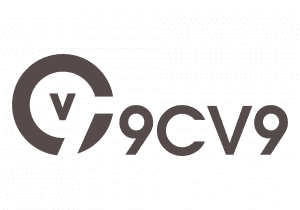








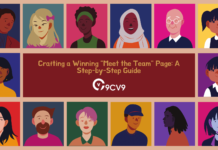





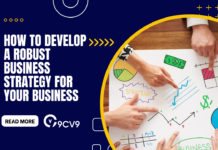





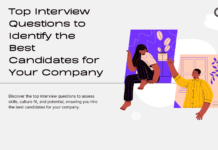
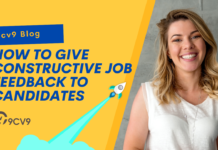


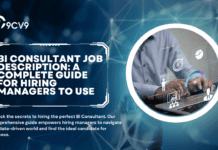


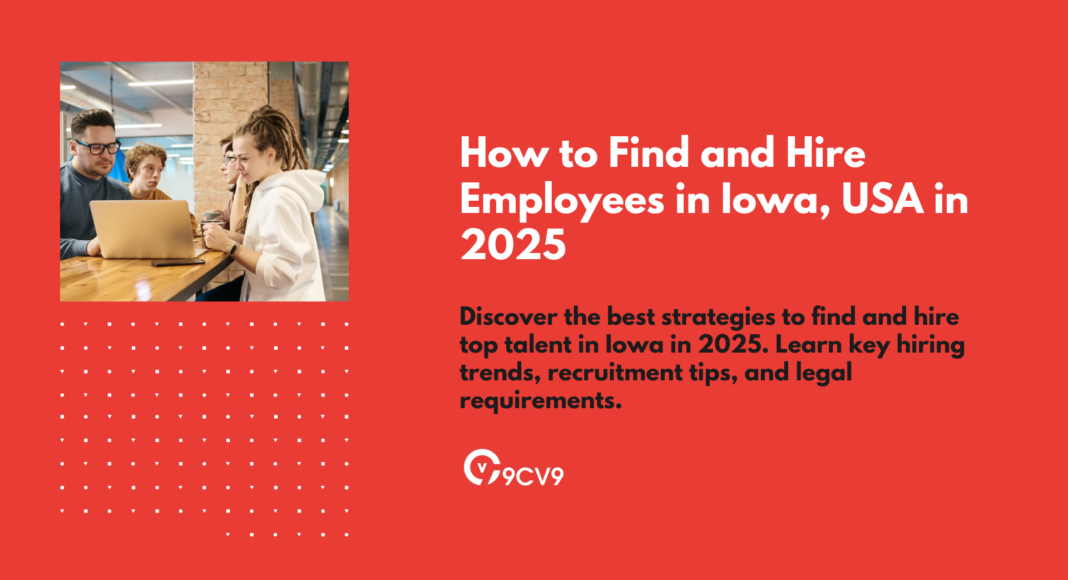


![Writing A Good CV [6 Tips To Improve Your CV] 6 Tips To Improve Your CV](https://blog.9cv9.com/wp-content/uploads/2020/06/2020-06-02-2-100x70.png)


